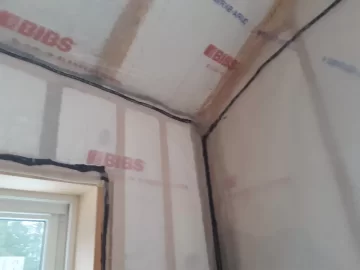I’ve had this cabin I’ve been working on for about ten years. With how Covid is changing things I’ve had a lot more time to work on it recently. My question is about how to keep the place warmer during the winter.
A few details about the cabin. It’s 24x30, and two story. It sits on posts, and has a wood skirt wrapped around it. The skirt has felt paper underneath and is pretty tight. I have R30 insulation in the attic, and R19 in the walls. The floor is about half done with R19 and that will be finished soon.
At some point I’ll need to bump the attic up to R49 minimum, and the floors up to R25 minimum.
So basically when it’s less than about 25 degrees the warmest I can get the place is about 60-65 degrees inside. This is using a VC Encore woodstove burning hardwood. Stove top temps 500-600 degrees. I’m worried what it’s going to be like when it’s -20 outside. This is in upstate NY.
Right now the insulation in the walls is exposed. It’s faced on the inside, but there is no drywall. Will drywalling the place help retain heat? Will it make that much of a difference bumping the attic and floor insulation up to code minimums or higher?
The cabin has newer doors and window (installed within the past ten years). Not super duper expensive units, but not 50 years old either.
All Windows and doors have been spray foamed around the edges.
The house doesn’t have siding on all sides yet, but has 1” sheathing on the exterior walls covered by house wrap.
I feel like for a newer, tightly built house I should be able to keep it warmer than this. The VC encore says it’s good for around 2,000 sq ft I believe. I’m a little less than 1400.
It’s a pretty open floor plan, with downstairs being all one big room (except for the bathroom) and upstairs being divided into 3 bedrooms. The house stays very close to the same temp in all the rooms.
Any advice on how to keep it warmer? I figure if I can’t get it to the mid 70’s inside when it’s around freezing outside, I’ll never be able to keep it in the 60’s inside when it’s negative temps outside.
I feel like the woodstove is big enough, but maybe it’s not.
Sorry for the long winded post
A few details about the cabin. It’s 24x30, and two story. It sits on posts, and has a wood skirt wrapped around it. The skirt has felt paper underneath and is pretty tight. I have R30 insulation in the attic, and R19 in the walls. The floor is about half done with R19 and that will be finished soon.
At some point I’ll need to bump the attic up to R49 minimum, and the floors up to R25 minimum.
So basically when it’s less than about 25 degrees the warmest I can get the place is about 60-65 degrees inside. This is using a VC Encore woodstove burning hardwood. Stove top temps 500-600 degrees. I’m worried what it’s going to be like when it’s -20 outside. This is in upstate NY.
Right now the insulation in the walls is exposed. It’s faced on the inside, but there is no drywall. Will drywalling the place help retain heat? Will it make that much of a difference bumping the attic and floor insulation up to code minimums or higher?
The cabin has newer doors and window (installed within the past ten years). Not super duper expensive units, but not 50 years old either.
All Windows and doors have been spray foamed around the edges.
The house doesn’t have siding on all sides yet, but has 1” sheathing on the exterior walls covered by house wrap.
I feel like for a newer, tightly built house I should be able to keep it warmer than this. The VC encore says it’s good for around 2,000 sq ft I believe. I’m a little less than 1400.
It’s a pretty open floor plan, with downstairs being all one big room (except for the bathroom) and upstairs being divided into 3 bedrooms. The house stays very close to the same temp in all the rooms.
Any advice on how to keep it warmer? I figure if I can’t get it to the mid 70’s inside when it’s around freezing outside, I’ll never be able to keep it in the 60’s inside when it’s negative temps outside.
I feel like the woodstove is big enough, but maybe it’s not.
Sorry for the long winded post



